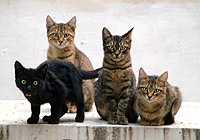Feline Immunodeficiency Virus (FIV)
FIV is a slow, chronic contageous disease of cats, due to the replication of a virus that is similar to the human AIDS virus. Even though FIV is closely related to human AIDS, the virus is very specific to members of the cat family.
Feline immunodeficiency virus (FIV) vaccination is quite controversial due to the interference of vaccinating with diagnostic testing. Like FeLV, FIV is a retrovirus and causes immunosuppression.

Transmission of FIV occurs through bite wounds. Due to their aggressive territorial behavior, non-neutered male cats are most commonly infected. Any cat that is bitten by another cat is at risk of contracting FIV. Casual contact between cats does not appear to be a major factor in disseminating the disease.
Lymphocytes are important cells involved in the body's immune (defense) system. FIV infects and destroys these lymphocytes. Without lymphocytes, immunodeficiency results and the body is open to infection. Symptoms associated with FIV are generally due to secondary bacterial, viral, and fungal infections.
3 Stages of FIV Infection
- Early symptoms of FIV generally go unnoticed. Within four to six weeks after exposure, enlargement of lymph nodes occur. These lymph nodes may remain enlarged for two to nine months.
- Early symptoms disappear and the infected animal enters a long period of latency. This is the quiet period and may last several years. Few (if any) clinical signs are observed.
- This last stage is the chronic or terminal phase of the infection. Secondary infections are common and may last months or years. More than 50 percent of infected cats have gum infections (gingivitis) and/or mouth infections (stomatitis). Skin, bladder, and respiratory infections are also very common.
The diagnosis of FIV is made by a veterinarian. The history, clinical symptoms of the disease, and the results of a specific blood test are instrumental in diagnosing the disease.
[ Search Articles ] [ Article Index ] [ Previous Page ]
